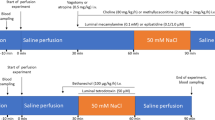Summary
The effects of adrenoceptor agonists and antagonists on the cholera-toxin-induced intestinal fluid accumulation and the mucosal levels of cAMP were investigated in vivo. Cholera toxin produced a marked fluid accumulation. Adrenaline inhibited the effect of the toxin in a dose-dependent manner. An α1-adrenoceptor blocking agent yohimbine antagonized the effect of adrenaline. The α1-adrenoceptor blocking agents prazosin and phenoxybenzamine failed to antagonize the effect of adrenaline. A high dose of a β-adrenoceptor blocking agent pindolol did not antagonize the effect of adrenaline. Yohimbine or pindolol alone did not produce any effects on the toxin-induced fluid accumulation. However, prazosin and phenoxybenzamine per se inhibited the toxin-induced fluid accumulation. An α2-selective agonist clonidine was slightly more potent than adrenaline, and was about 100-fold more potent than the α1-selective agonist methoxamine in inhibiting the cholera-toxin-induced intestinal secretion. Clonidine, adrenaline and methoxamine failed to reduce the mucosal levels of cAMP, while these α-adrenoceptor agonists inhibited the toxin-induced fluid accumulation in the same preparations. These results suggest that the stimulation of α2-adrenoceptors inhibit the cholera-toxin-induced intestinal secretion without reducing the whole mucosal levels of cAMP.
Similar content being viewed by others
References
Aktories K, Shultz G, Jakobs KH (1980) Regulation of adenylate cyclase activity in hamster adipocytes: inhibition by prostaglandins, α-adrenergic agonists and nicotinic acid. Naunyn-Schmiedeberg's Arch Pharmacol 312:167–173
Berthelsen S, Pettinger WA (1977) A functional basis for classification of α-adrenergic receptors. Life Sci 21:595–606
Beubler E, Lembeck F (1980) Inhibition by morphine of prostaglandin E1-stimulated secretion and cyclic adenosine 3′, 5′-monophosphate formation in the rat jejunum in vivo. Br J Pharmacol 68:513–518
Blaschke TF, Melmon KL (1980) Antihypertensive agents and the drug therapy of hypertension. In: Gilman AG, Goodman LS, Gilman A (eds) Goodman's and Gilman's the pharmacological basis of therapeutics. Macmillan Publishing Co., Inc., New York, pp 793–818
Carpenter CCJ, Curlin GT, Greenough WB (1969) Response of canine Thirty-Vella jejunal loops to cholera exotoxin and its modification by ethacrynic acid. Infect Dis 120:332–338
Dubocovich ML, Langer SZ (1980) Pharmacological differentiation of presynaptic inhibitory α-adrenoceptors and opiate receptors in the cat nictitating membrane. Br J Pharmacol 70:383–393
Farack UM, Kautz U, Loeschke K (1981) Loperamide reduces the intestinal secretion but not the mucosal cAMP accumulation induced by choleratoxin. Naunyn-Schmiedeberg's Arch Pharmacol 317:178–179
Field M, McColl I (1973) Ion transport in rabbit ileal mucosa. III. Effects of catecholamines. Am J Physiol 225:852–857
Field M, Sheerin HE, Henderson A, Smith PL (1975) Catecholamine effects on cyclic AMP levels and ion secretion in rabbit ileal mucosa. Am J Physiol 229:86–92
Guerrant RL, Chen LC, Sharp GWG (1972) Intestinal adenylate-cyclase activity in canine cholera: correlation with fluid accumulation. J Infect Dis 125:377–381
Jakobs KH (1978) Synthetic α-adrenergic agonists are potent α-adrenergic blockers in human platelets. Nature 274:819–820
Kimberg DV, Field M, Johnson J, Henderson A, Gershon E (1971) Stimulation of intestinal mucosal adenyl cyclase by cholera enterotoxin and prostaglandins. J Clin Invest 50:1218–1230
Lange S, Holmgren J (1978) Protective antitoxic cholera immunity in mice: influence of route and number of immunizations and mode of action of protective antibodies. Acta Pathol Microbiol Scand Sec C 86:145–152
Langer SZ (1974) Presynaptic regulation of catecholamine release. Biochem Pharmacol 23:1793–1980
Langer SZ (1980) Presynaptic regulation of the release of catecholamines. Pharmacol Rev 32:337–362
Lee MK, Coupar IM (1980) Inhibition of intestinal secretion without reduction of cyclic AMP levels. Eur J Pharmacol 68:501–503
Lowry OH, Rosebrough NJ, Farr AL, Randall RJ (1951) Protein measurement with the Folin phenol reagent. J Biol Chem 193:265–275
Lönnroth I, Holmgren J, Lange S (1977) Chlorpromazine inhibits cholera toxin-induced intestinal hypersecretion. Med Biol 55:126–129
Nakaki T, Nakadate T, Ishii K, Kato R (1981) Postsynaptic alpha-2 adrenergic receptors in isolated rat islets of Langerhans: inhibition of insulin release and cyclic 3′:5′-adenosine monophosphate accumulation. J Pharmacol Exp Ther 216:607–612
Nakaki T, Nakadate T, Yamamoto S, Kato R (1982) Alpha-2-adrenergic inhibition of intestinal secretion induced by prostaglandin E1, vasoactive intestinal peptide and dibutyryl cyclic AMP in rat jejunum. J Pharmacol Exp Ther: in press
Ogasawara B, Ogawa K, Hayashi H, Sassa H (1981) Plasma renin activity and plasma concentrations of norepinephrine and cyclic nucleotide in heart failure after prazosin. Clin Pharmacol Ther 29:464–471
Pierce NF, Greenough WB, Carpenter CCJ (1971) Vibrio cholerae enterotoxin and its mode of action. Bacteriol Rev 35:1–13
Sabol SL, Nirenberg M (1979) Regulation of adenylate cyclase of neuroblastoma x glioma hybrid cells by α-adrenergic receptors. J Biol Chem 254:1913–1920
Schafer DE, Lust WD, Sircar B, Goldberg ND (1970) Elevated concentration of adenosine 3′:5′-cyclic monophosphate in intestinal mucosa after treatment with cholera toxin. Proc Natl Acad Sci USA 67:851–856
Serebro HA, Iber FL, Yardley JH, Hendrix TR (1969) Inhibition of cholera toxin action in the rabbit by cycloheximide. Gastroenterology 56:506–511
Sharp GWG, Hynie S (1971) Stimulation of intestinal adenylate cyclase by cholera toxin. Nature 229:266–269
Starke K, Langer SZ (1979) A note on terminology for presynaptic receptors. In: Langer SZ, Starke K, Dubocovich ML (eds) Presynaptic receptors. Pergamon Press, Oxford, pp 1–3
Tanaka T, Starke K (1979) Binding of 3H-clonidine to an α-adrenoceptor in membranes of guinea-pig ileum. Naunyn-Schmiedeberg's Arch Pharmacol 309:207–215
Valiulis E, Long JF (1973) Effects of drugs on intestinal water secretion following cholera toxin in guinea pigs and rabbits. Physiologist 16:475
Author information
Authors and Affiliations
Rights and permissions
About this article
Cite this article
Nakaki, T., Nakadate, T., Yamamoto, S. et al. α2-Adrenoceptors inhibit the cholera-toxin-induced intestinal fluid accumulation. Naunyn-Schmiedeberg's Arch. Pharmacol. 318, 181–184 (1982). https://doi.org/10.1007/BF00500478
Received:
Accepted:
Issue Date:
DOI: https://doi.org/10.1007/BF00500478



